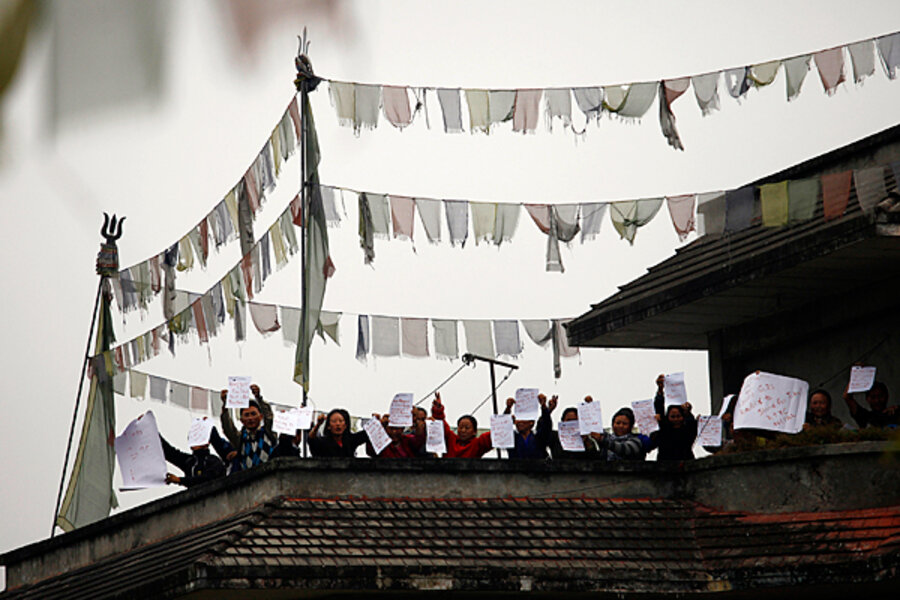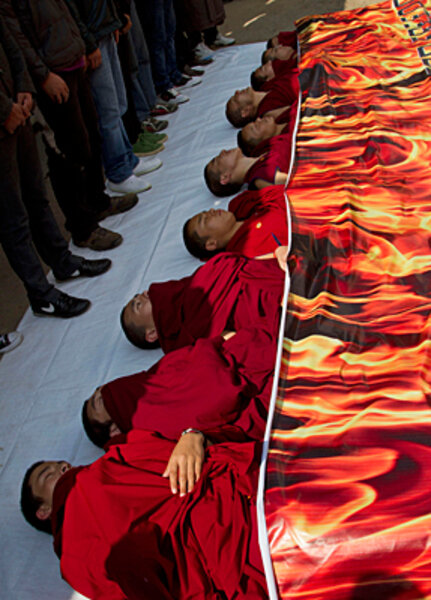China's crackdown grows as Tibetan self-immolations increase
Loading...
| Hongyuan, China
The young man's hands began to shake, and he tugged at his fingers to keep them still. The 20-year-old ethnic Tibetan was terrified of the police finding out that he'd spoken about the Buddhist monks who've been burning themselves alive.
"They're doing it because they want freedom," said the man, a livestock trader who asked that his name not be used because of safety concerns.
He paused before adding, "Because we want freedom."
Since March, according to rights groups, 10 Tibetan Buddhist clergy have set themselves on fire in China's western Sichuan province. Almost all those have come in or around the town of Aba, 50 miles as the crow flies to the west of Hongyuan, amid mountain ranges at the edge of the Tibetan plateau where yaks graze and prayer flags inscribed with mantras and blessings flap in the wind.
At least five reportedly have died in the fiery exclamations of Tibetan complaint about restrictions on their culture and religion and the continued exile of their spiritual leader, the Dalai Lama.
The chain of self-immolations – comprising six monks, three former monks and a nun – is unprecedented in modern Tibetan history. The most recent occurred Oct. 25.
Tough response
The response so far by the Chinese Communist Party has been to knuckle down even more. Towns surrounding Aba are stacked with police. Internet access is shut off in many spots. Those suspected of sympathizing closely with activist monks are said to have disappeared.
A McClatchy reporter was detained for two hours Saturday when he was pulled over at a police checkpoint 15 miles from Hongyuan on the winding road toward Aba. He was released only after photos were deleted from his camera and he agreed not to stop again in Hongyuan on the way out, a condition emphasized by threats to his driver and the multiple vehicles that followed him.
Beyond issues particular to the Communist Party's policy in Tibetan areas, the situation also may hint at the limits of the effectiveness of Beijing's authoritarian approach toward social unrest.
Conversations at Hongyuan and outlying villages suggest that the government's tough response hasn't deterred angry Tibetans. Rather, it now threatens to alienate those who were accepting of the regime.
One Tibetan businessman interviewed in the vicinity said that he appreciated the roads and offices the government built. The man, who gave his name as Tsering, said he understood the pragmatic reasons that his daughter received Tibetan language instruction at school only two or three times a week, while she was taught Mandarin Chinese every day.
When talking about the self-immolations, however, Tsering, 29, was adamant. "The monks are asking for justice," he said.
The first self-immolation came on March 16, when a 21-year-old monk named Phuntsog lit himself aflame, apparently to mark the third anniversary of riots that struck Tibet and neighboring territories. Tibetans claim that in one incident during the 2008 disturbances, police shot 13 people dead at a demonstration in Aba.
After Phuntsog's death, six monks — including Phuntsog's brother and uncle — were sentenced to prison or labor camps, according to Free Tibet, a London-based Tibetan advocacy group.
In April, about 300 monks from Phuntsog's Kirti Monastery allegedly were taken away in trucks, prompting the United Nations to inquire about their whereabouts. The Chinese government denied that monks had disappeared from the monastery, although it did note that some were taken away for "education."
The crackdown didn't stop monks from spreading their complaints via pamphlets in the area nor did it put an end to people soaking themselves with gasoline and lighting matches; six self-immolations took place in October alone.
Many Tibetans say that the country's Han Chinese majority, with the muscle of the Communist Party behind it, essentially is occupying their lands and moving to monopolize business interests while marginalizing the Tibetan language and way of life.
The Chinese government maintains that it liberated Tibetans from a feudal existence, and now works to improve their lives with billions of dollars in infrastructure projects. Any outbursts of Tibetan rage, the government maintains, are due to outside influences personified by the Dalai Lama.
'Terrorism in disguise?'
Speaking about the self-immolations, Foreign Ministry spokeswoman Jiang Yu said in a news briefing Oct. 19 that the Dalai Lama and those around him had encouraged "more people to follow suit," an action that Jiang said amounted to "terrorism in disguise."
Later in the month, the Dalai Lama, who fled Tibet in 1959, said it was China's own "ruthless policy" that was to blame.
At one Tibetan monastery nestled by snow-capped hills in the region, there are no photographs of the Dalai Lama visible from outside the compound's main buildings. Police are stationed nearby.
In the living quarters of one of its senior monks, though, a large portrait of the Tibetan leader greets visitors.
The monk, whose name and location McClatchy is withholding to prevent retribution from local officials, said he'd tried last August to visit Aba, which is known in Tibetan as Ngaba.
"The police wouldn't even let me into the town," said the monk, whose elderly uncle smiled a toothy grin and pulled a cell phone from the folds of his vest to show a visitor his picture of the Dalai Lama. "The living conditions for monks in Aba aren't very good, and there's a conflict now between the Han and the Tibetans there."
Standing in a prayer hall that a group of young monks was sweeping for a ceremony the next day, the soft-spoken man in a crimson robe and yellow fleece jacket said that, "a lot of these problems have roots in the 2008 troubles."
'We are all afraid of the government'
Here in Hongyuan, police now swarm the streets. Many of those patrolling the predominantly ethnic Tibetan town appear to be Han Chinese.
"A lot of people have been taken away by the government," said the livestock trader, who wore a puffy neon-blue jacket and jeans. "A lot of Tibetans feel that we aren't free. We aren't allowed to put up pictures of the Dalai Lama. Do you understand what I'm saying?"
He was joined by a group of friends, a couple of whom wore small likenesses of the Dalai Lama at the ends of thin leather necklaces that they tucked beneath their shirts.
One of them, another Tibetan trader in his early 20s, spoke up, "We are all afraid of the government."
A few blocks away, a policeman sat in his car and filmed every person who walked by an intersection.
Chinese officials have tried suppressing news about the extent of the security presence and pressure on Tibetans in places such as Hongyuan.
When the McClatchy reporter was stopped while traveling in the direction of Aba, one man in the small police stand where he was held set the ground rules: "It is against the law to write things down in here."
The reporter was told four different times that he could leave, only to be stopped by further demands: handing over his camera, explaining to two additional plainclothes officers why he was in the area and, finally, tearing out a page of notes that contained the name of a local police commander, Qiu Po.
In the meantime, a driver whom McClatchy had hired was taken outside and told that he could be arrested.
The next morning, a police officer visited the reporter's room in a hotel some four hours away. The officer said that news media were hereby forbidden from traveling in the direction of Hongyuan. It was permissible, he said, to remain near the town of Songpan, where Tibetans and Han Chinese dressed as Tibetans cater to tourist groups flying in every day from Beijing.
Later in the afternoon, a second police officer stopped the reporter outside the hotel and, accompanied by three men in plainclothes, questioned him about every detail of his trip.
The Han Chinese officer, surnamed Jiang, seemed particularly anxious to know what the Tibetans had been saying.






